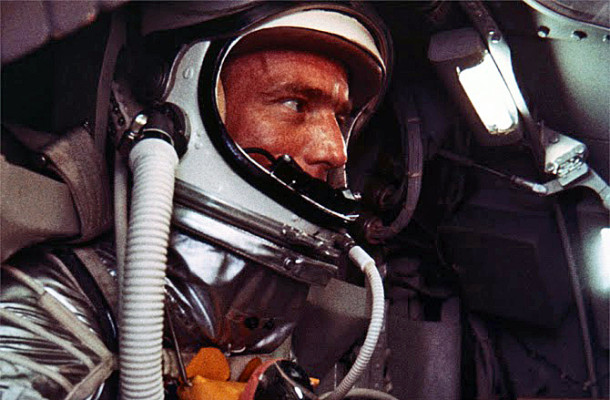
Fifty-three years ago this month, Mercury Astronaut M. Scott Carpenter orbited the Earth three times aboard his Aurora 7 Mercury spacecraft. In doing so, Carpenter became the second American to reach Earth orbit.
Project Mercury was America’s first manned spaceflight program. A total of six (6) flights took place between May of 1961 and May of 1963. The first two (2) flights were suborbital missions while the remainder achieved low Earth orbits. In February of 1962, John H. Glenn, Jr. became the first American to orbit the Earth during the Mercury-Atlas 6 (MA-6) mission.
Deke Slayton was to fly the Mercury-Atlas 7 (MA-7) mission. However, before that happened, the dreaded flight surgeon cabal grounded Slayton for what they deemed was a heart murmur. Despite Slayton’s utter incredulity and vehement protests, the decision held. Project Mercury officials maintained that the space program could ill afford the negative political fallout occasioned by the death of an astronaut on-orbit.
With Slayton grounded indefinitely, NASA selected Malcom Scott Carpenter to pilot the Mercury-Atlas 7 mission. Carpenter was member of the Original Seven selected by NASA for the Mercury Program in 1959. He was well prepared for the flight since he had just trained as Glenn’s MA-6 backup. As was the practice at that time, Carpenter named his Mercury spacecraft. The appellation he gave his celestial chariot was Aurora 7.
The launch of MA-7 took place on Thursday, 24 May 1962 from LC-14 at Cape Canaveral, Florida. Lift-off time was 12:45:16 UTC. Ascent performance of the stage-and-a-half Atlas D booster was nearly flawless as it inserted Aurora 7 into a 140-nm x 83-nm elliptical orbit. Having been cleared for at least 3 orbits, Carpenter quickly got down to the business of spaceflight.
Much of the activity on the first and second orbits involved Carpenter maneuvering his spacecraft, conducting scientific experiments and observing the Earth from space. Among other discoveries, he discerned that John Glenn’s mysterious “fireflies” were simply particles of ice and frost that had accumulated on the shadow side of the spacecraft. When the spacecraft structure was bumped or vibrated, these particles would disperse from the external surface of the spacecraft and float away into space. Once in the presence of strong sunlight, the particles appeared to glow or be luminescent.
A combination of the astronaut’s spacecraft maneuvering and an intermittently malfunctioning pitch horizon scanner left Carpenter with less than half of his maneuvering fuel left at the start of the third and final orbit. Carpenter compensated admirably by barely using his thrusters during Orbit 3. Indeed, nearing the time of retro-fire, Aurora 7 still had 40 percent of his fuel remaining in both the manual and automatic flight control systems.
As retro-fire approached, the intermittent pitch horizon scanner malfunction reappeared at a most inopportune moment. The automatic stabilization and control system suddenly would not hold Aurora 7 in the proper attitude for retro-fire; heatshield 34 degrees above the horizon at zero yaw angle. Carpenter subsequently switched to manual mode in an attempt to align the spacecraft properly for retro-fire.
When nominal time for retro-fire came, the retro-rockets did not automatically ignite. Carpenter had to do that manually. But he was 3 seconds late. Worst, Aurora 7 was still yawed 25 degree to the right. And to top it off, retro-thrust was 3 percent low. All of this meant that Aurora 7 would overshoot the nominal landing point by 215 nautical miles.
The trip down through the atmosphere was sporty in that Carpenter ran out of attitude control system fuel early during the descent. This meant that there was no means to propulsively damp the side-to-side oscillations that the Mercury spacecraft normally exhibited during reentry. These oscillations became dangerous when they exceeded about 10 degrees. That is, the spacecraft could tumble end-over-end if left unchecked.
Carpenter simultaneously eyed the altimeter and spacecraft angle-of-attack. As the latter built-up dangerously, his only recourse was to manually fire the drogue earlier than planned in attempt to arrest Aurora 7’s oscillatory motion. He did so at 25,000 feet. The spacecraft’s side-to-side oscillations were stopped. Carpenter then deployed his main parachute at 9,500 feet. Splashdown occurred at 17:41:21 UTC at a point 108 nautical miles northeast of Puerto Rico.
Since Aurora 7 was listing badly and help was about an hour away, Carpenter extricated himself from the spacecraft and deployed his life raft. While a radio beacon helped recovery forces locate him, there was no voice communication between the astronaut and his rescuers. Carpenter was on the surface of the briny deep nearly 3 hours before being picked-up by rescue helicopters and safely delivered to the carrier USS Intrepid. Some six (6) hours later, Aurora 7 was brought onboard the USS John R. Pierce.
Mercury-Atlas 7 was Scott Carpenter’s only space mission. A combination of factors, including less than amicable relations with Mercury Mission Control management, led to this being the case. During the intervening years, many stories alluding to pilot error or inattention as the cause of Aurora 7’s landing overshoot have been circulated. Indeed, much like Gus Grissom’s experience with the loss of his Liberty Bell spacecraft, these stories and explanations have been around long enough that they are now accepted as the “truth”.
Criticism of another’s performance comes easily in this world. However, as Theodore Roosevelt once pointed out, it really is “The Man in the Arena” who counts most. It is he and he alone who faces and reacts to the actual moment of trial. No one but he knows the utter reality of that moment and the vicissitudes thereof. While others may criticize, we go on record here to acknowledge and honor M. Scott Carpenter for his heroic and pioneering contributions to early American manned spaceflight.

